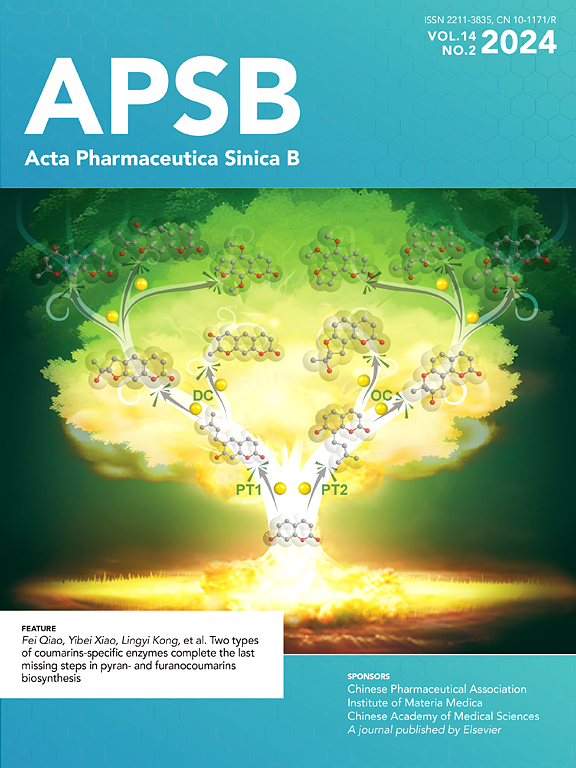利用微电机驱动的微针自主给药和疤痕微环境重塑治疗增生性疤痕
IF 14.7
1区 医学
Q1 PHARMACOLOGY & PHARMACY
引用次数: 0
摘要
增生性瘢痕是一种由皮肤损伤引起的纤维增生性疾病。目前的治疗方式受到致密和坚硬的疤痕组织的限制,这阻碍了有效的药物输送。此外,成纤维细胞自噬活性不足阻碍了它们的凋亡,导致过度的基质沉积。在这里,我们开发了一种主动微针(MN)系统,通过将微马达驱动的药物输送与自噬调节结合起来,重塑疤痕微环境,来克服这些挑战。具体来说,将碳酸氢钠和柠檬酸作为内置引擎引入纳米颗粒中,产生二氧化碳气泡,从而增强药物向致密疤痕组织的横向和垂直扩散。该系统同时包裹姜黄素(Cur),一种自噬激活剂,和曲安奈德(TA),通过上调自噬活性协同诱导成纤维细胞凋亡。体外研究表明,活性MNs在分离的疤痕组织中实现了有效的药物渗透。兔增生性瘢痕模型显示TA-Cur MNs显著降低瘢痕升高指数,抑制I型胶原和转化生长因子-β1 (TGF-β1)表达,升高LC3蛋白水平。这些发现强调了活性MN系统在纤维化疾病治疗中作为自主增强药物传递和自噬靶向治疗的有效平台的潜力。本文章由计算机程序翻译,如有差异,请以英文原文为准。

Autonomous drug delivery and scar microenvironment remodeling using micromotor-driven microneedles for hypertrophic scars therapy
Hypertrophic scar is a fibrous hyperplastic disorder that arises from skin injuries. The current therapeutic modalities are constrained by the dense and rigid scar tissue which impedes effective drug delivery. Additionally, insufficient autophagic activity in fibroblasts hinders their apoptosis, leading to excessive matrix deposition. Here, we developed an active microneedle (MN) system to overcome these challenges by integrating micromotor-driven drug delivery with autophagy regulation to remodel the scar microenvironment. Specifically, sodium bicarbonate and citric acid were introduced into the MNs as a built-in engine to generate CO2 bubbles, thereby enabling enhanced lateral and vertical drug diffusion into dense scar tissue. The system concurrently encapsulated curcumin (Cur), an autophagy activator, and triamcinolone acetonide (TA), synergistically inducing fibroblast apoptosis by upregulating autophagic activity. In vitro studies demonstrated that active MNs achieved efficient drug penetration within isolated scar tissue. The rabbit hypertrophic scar model revealed that TA-Cur MNs significantly reduced the scar elevation index, suppressed collagen I and transforming growth factor-β1 (TGF-β1) expression, and elevated LC3 protein levels. These findings highlight the potential of the active MN system as an efficacious platform for autonomous augmented drug delivery and autophagy-targeted therapy in fibrotic disorder treatments.
求助全文
通过发布文献求助,成功后即可免费获取论文全文。
去求助
来源期刊

Acta Pharmaceutica Sinica. B
Pharmacology, Toxicology and Pharmaceutics-General Pharmacology, Toxicology and Pharmaceutics
CiteScore
22.40
自引率
5.50%
发文量
1051
审稿时长
19 weeks
期刊介绍:
The Journal of the Institute of Materia Medica, Chinese Academy of Medical Sciences, and the Chinese Pharmaceutical Association oversees the peer review process for Acta Pharmaceutica Sinica. B (APSB).
Published monthly in English, APSB is dedicated to disseminating significant original research articles, rapid communications, and high-quality reviews that highlight recent advances across various pharmaceutical sciences domains. These encompass pharmacology, pharmaceutics, medicinal chemistry, natural products, pharmacognosy, pharmaceutical analysis, and pharmacokinetics.
A part of the Acta Pharmaceutica Sinica series, established in 1953 and indexed in prominent databases like Chemical Abstracts, Index Medicus, SciFinder Scholar, Biological Abstracts, International Pharmaceutical Abstracts, Cambridge Scientific Abstracts, and Current Bibliography on Science and Technology, APSB is sponsored by the Institute of Materia Medica, Chinese Academy of Medical Sciences, and the Chinese Pharmaceutical Association. Its production and hosting are facilitated by Elsevier B.V. This collaborative effort ensures APSB's commitment to delivering valuable contributions to the pharmaceutical sciences community.
 求助内容:
求助内容: 应助结果提醒方式:
应助结果提醒方式:


